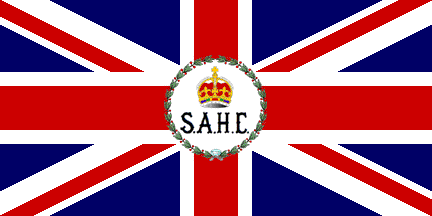
Last modified: 2006-01-14 by bruce berry
Keywords: botswana | bechuanaland | high commissioner |
Links: FOTW homepage |
search |
disclaimer and copyright |
write us |
mirrors
 image
by Martin Grieve, 24 Nov 2005
image
by Martin Grieve, 24 Nov 2005Prior to independence on 30 September 1966, Botswana was the British protectorate of Bechuanaland. The Bechuanaland Protectorate was administered through the office of the High Commissioner in South Africa which was created by letters patent in 1878. The High Commissioner was charged with the conduct of British relations with the South African Republic (Transvaal) and the Orange Free State, as well as with "those native states and tribes outside the colonies of the Cape and Natal, including Swaziland" (which was administered by the government of the South African Republic under the convention of 1894). The High Commissioner was also governor of Basutoland (now Lesotho) and supervised the affairs of the Bechuanaland Protectorate (now Botswana) and Swaziland.
The High Commissioner flew a British Union Flag charged in the centre, on a white roundel, with the letters S.A.H.C. in black above which was a Tudor crown, all within a green garland of laurel. This flag which was taken into use in 1907, is similar in design to that of the Western Pacific High Commissioner.
This flag was used until 1931 after which the posts of Governor-General and High Commissioner were separated. The governor-general of South Africa would henceforth fly a royal-blue flag bearing the royal crest with two scrolls inscribed "Union of South Africa" and "Unie van Suid-Afrika" respectively. The High Commissioner, based in South Africa, was represented by a Resident Commissioner in each of the high commission territories (Basutoland, Bechuanaland and Swaziland). Of these, only the Resident Commissioner for Basutoland, which was a crown colony, had a personal flag. The other two territories were British protectorates and thus their inhabitants were merely "protected persons".
The flag of the High Commissioner for Basutoland, the Bechuanaland Protectorate
and Swaziland was a similar design to that used previously by the South
African High Commissioner, being a British Union Flag charged in the centre,
on a white roundel, with the letters H.C. in black, above which was an
imperial crown, all within a green garland of laurel. The flag fell into
abeyance following the independence of the high commission territories
in the late 1960s.
Bruce Berry, 19 February 1998
The complete sequence was:
The Batswana were in conflict with the Boers and asked the British
for assistance.
1884. Deputy Commissioner appointed.
1885. With concurrence of Chief Khama the whole of Bechuanaland
was placed under British protection. The southern part of the country
was constituted a Crown colony and called British Bechuanaland.
1895. Annexed to Cape Colony.
Northern Bechuanaland was treated as though it was part of British
Bechuanaland until 1895 when it was made a separate territory and administered
by a Resident Commissioner under the High Commissioner for South Africa.
David Prothero, 21 March 1999
I have a history book with a map as of 1895 which shows:
(1) British Protectorate of Bechuanaland;
(2) British Colony Bechuanaland; and
(3) Togoland (north of Zululand)
Was the British High Commissioner's flag used both in (1) and (2) ?
Where was Togoland (Amatogoland) and what flag was flown?
Nozomi Kariyasu, 15 Nov 2003
Nozomi, the British South Africa High Commissioner's flag was not introduced
until 1907.
To answer you other queries:
(1) On land the flag of a British colony or protectorate was the Union Jack. The
High Commissioner's flag (1935 design) may have been used on land after 1942;
before that it should have been used only when the High Commissioner was
embarked in a vessel.
(2) The colony of Bechuanaland was incorporated into Cape Colony in 1895
(3) I think the spelling should be Tongaland / Amatongaland. It became a British
protectorate in 1895. In 1897 it was incorporated into Zululand, which was
annexed to Natal in the same year. I believe the Union Jack was used.
David Prothero, 15 Nov 2003
 image
by Martin Grieve, 24 Nov 2005
image
by Martin Grieve, 24 Nov 2005
The flag of the High Commissioner for Basutoland, the Bechuanaland Protectorate and Swaziland was taken into use in 1931 and used until the independence of the various colonies - Bechuanaland on 30 September 1966 as the Republic of Botswana; Basutoland as the Kingdom of Lesotho on 4 October 1966 and Swaziland as the Kingdom of Swaziland on 06 September 1968.
The flag of the High Commissioner was a similar design to that used previously by the South
African High Commissioner, being a British Union Flag charged in the centre,
on a white roundel, with the letters H.C. in black, above which was an
imperial crown, all within a green garland of laurel. The flag fell into
abeyance following the independence of the high commission territories
in the late 1960s.
Bruce Berry, 24 Mar 1999
 by Olivier Touzeau, 14 Oct 2002
by Olivier Touzeau, 14 Oct 2002
This image is from the series of Cigarette Silks Iron-on Transfers the subject
of which is : Nation Animals & Flags which shows "Bechuana" (without "land" ... and without
its eland...)
Olivier Touzeau, 14 Oct 2002
Those "cigarette silks" include some pretty fanciful flags, not to mention
oddly chosen animals. The eland chosen for Bechuanaland isn't entirely
inappropriate, although it is better known in South Africa and in fact
appears as the supporters (left and right) in the arms of the
Eastern
Cape.
Mike Oettle, 14 Oct 2002